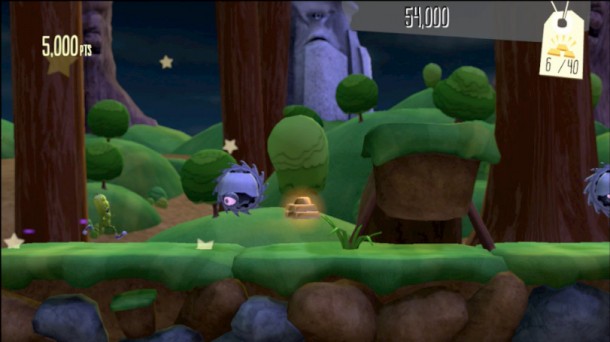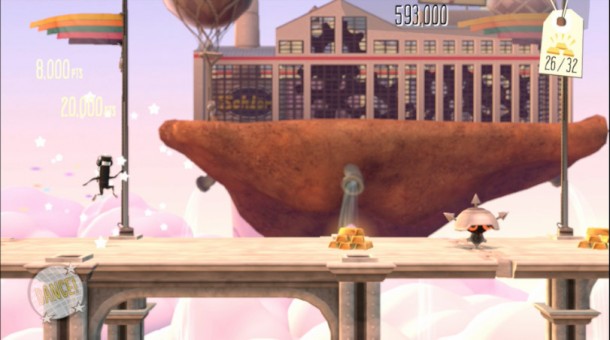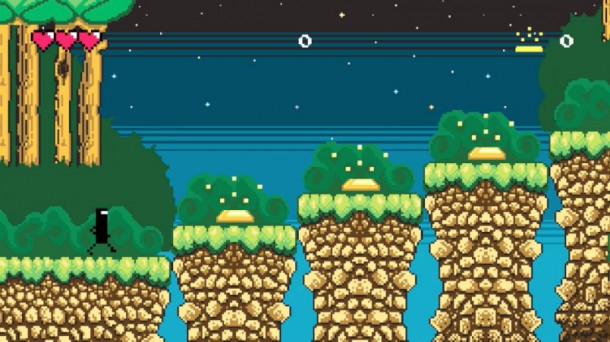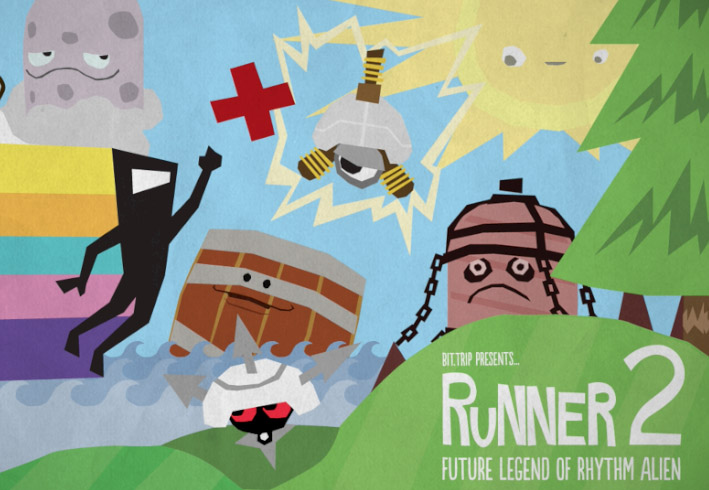“Daddy, look at him go!”
And with those words, my 3-year-old daughter begins to run in place, jump, lie down, twirl, and kick. She’s laughing and giggling the entire time, almost uncontrollably, as she watches an anthropomorphic pickle do the same maneuvers on the television screen. When the pickle runs into a wall or a misses a jump and falls, she yells “Oh no! There he goes again!” When the music changes to the actions, she sings “My shoes are instruments!”
My daughter is watching me play BIT.TRIP Runner 2. Or, perhaps it’s better to say that she’s watching me fail and fail and fail until I finally make it past simple obstacles. I’m learning and getting better, advancing further each time, but man, I’ve never seen her giggle that much at a game. I purposefully crash into things just to get her reaction. I realize that I’m performing a musical marathon for her, filled with blips and beeps, jumps and slides, and she’s eating up every second.
And so I keep playing it, because no matter how often failure occurs it becomes exponentially more enjoyable by doing so.
That’s what BIT.TRIP Runner 2 is: the best kind of failure.

Runner 2 is a music rhythm game more than an action game. Sure, its visuals look fantastic and its levels are designed well, the gameplay is spot on and the runs provide plenty of variety. Yes, I need to jump, slide, and kick my way to goals. But the experience is all about the music and how I react to it. Each button either jumps, crouches, slides, blocks, or kicks, depending on what’s required on screen. As a side-scrolling runner, the mechanic becomes familiar, but it’s really only half of the gameplay.
By paying attention to the way the music changes (sounds and instruments are added to the beat depending on the amount of gold and crosses found on a level) it becomes obvious how much of the game can be mastered by just listening. In the early levels I remembered the beat and predicted the next sounds (and therefore actions) so well that I was able to complete some of them with my eyes closed. It almost captures the magic of the early Guitar Hero games, where it was timing and the anticipation of notes and music that drove the experience. In Runner 2, however, the slight variety in hitting actions (or avoiding obstacles altogether) can affect the sound coming out of the speakers.
[pullquote_right]“My shoes are instruments!”[/pullquote_right]
“Rhythm action game” is probably the best way to describe Runner 2’s genre. It’s a transformation of the purest rhythm game controls into actions on the screen. During later levels, understanding the rhythm becomes more important, and some sections are nearly impossible to complete without listening to the music as well. Thankfully the game is extremely friendly, and failure is welcome as a part of the learning experience. “Learning” here equates to understanding what actions and obstacles precede each other. Downward stairs almost always end with a series of perfectly-placed jumps, for instance. Failing to nail them doesn’t deduct points or “lives”, but rather sends us flying back to the last generously-placed checkpoint. As my daughter becomes more in love with the game, there’s no issue with allowing her to grab the controller and mash buttons to see how far she gets. There are no repercussions. Failure is expected and welcomed.

With the number of secrets hidden in the game, failure becomes even more of a positive, and even becomes another tool on my belt. If I see a path that leads to an alternative exit or a chest that is just out of reach, I’ll let myself hit an obstacle just to be sent back to the checkpoint to try again. And because of how quickly the game resets to that point — while remaining on that level — it allows for an almost natural transition, more so than other runners. I can tweak my moves and reactions to make sure that I get not only the best outcome, but also the highest score. With live buddy leaderboards displayed before and after every course it’s the sort of carrot that constantly dangles in front of my face.
That does lead to a lot of repetition, though. There really isn’t a lot of variety in the game, and some courses can lead to a bit of frustration when failure comes as naturally as breathing. That equates to attempting a section again and again until I’m able to finally get to the goal. One in particular saw me try for nearly 15 minutes, accruing something near 35 or 40 failures before I completed it, each time honing my moves until I finally got it. That led me, at one point, to put the game away for over a week before I was able to allow myself to get back into it.

Thankfully, the game treats failure like it treats the rest of its design: with happiness and joy. My daughter even began to love watching me crash into walls because it sends me zooming back to the checkpoint each time, her arms flailing as she mimics Commander Video or Unkle Dill. The bright and colorful backgrounds are stunning and cheerful, making even the most frustrating courses enjoyable to screw up.
I guess that’s what makes this such an amazingly fun experience. Even when I crash and burn I’m having fun. Even when I’m frustrated I can look at my 3-year-old dancing to the music and jump-kicking the couch as ComVid does. It’s a game to “play”, not to “complete”, and because of that it’s an excellent palate cleanser when I want to let my mind wander and artistic muscle memory kick in.
“My shoes are instruments!”
Yes they are, kiddo.
This review is based on a retail copy of the game purchased from the Wii U eShop by the reviewer. The game was played on a combination of easy, regular and hard modes, and online leaderboards were viewed.


No Comments